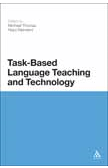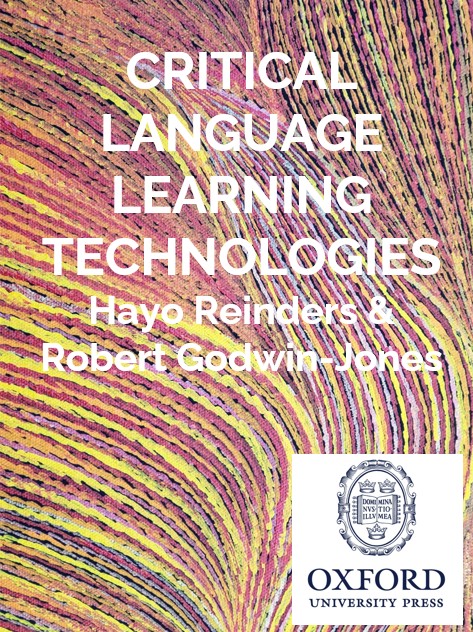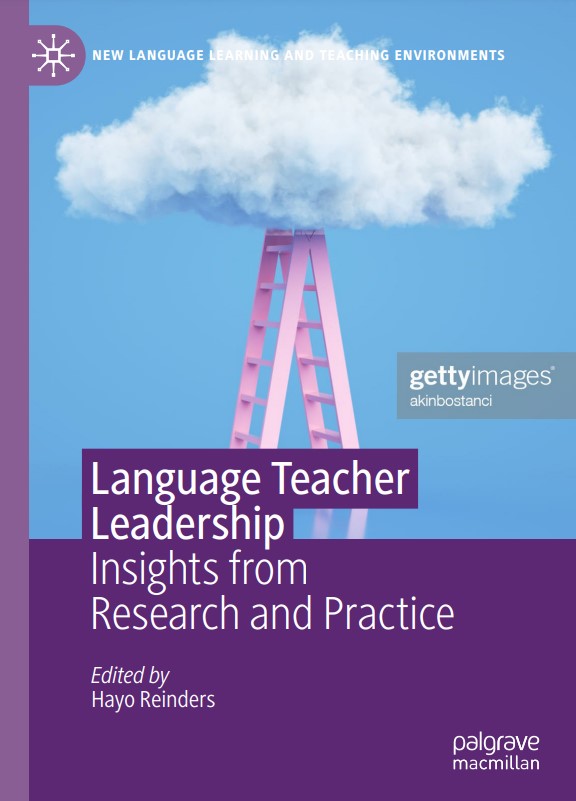Books > Task based teaching technology
Thomas, M. and Reinders, H. (Eds.). (2010). Task-based language teaching and technology. Continuum. Available here as a hardcover and NEW as a paperback here
.
This edited collection considers the relationship between task-based language teaching (TBLT) and technology-enhanced learning. TBLT is concerned with a number of macro-tasks such as information gathering and problem-solving as well as evaluative tasks, all of which are increasingly available via online and Web-based technologies. Technology Enhanced Learning refers to a broad conception of technology use in the language classroom and incorporates a range of interactive learning technologies such as Interactive Whiteboards and mobile learning devices.
The popularity of Web 2.0 technologies (blogs, wikis, social networking sites, podcasting, virtual worlds), as well as practical applications of mobile learning, place a fresh emphasis on creating project-orientated language learning tasks with a clear real-world significance for learners of foreign languages. This book examines the widespread interest in these new technology-enhanced learning environments and looks at how they are being used to promote task-based learning. This book will appeal to practioners and researchers in applied linguistics, second language acquisition and education studies.
Table of Contents
List of Abbreviations List of Figures and Tables List of Contributors Foreword Rod Ellis 1. Introduction Michael Thomas and Hayo Reinders PART I. RESEARCH ON TASKS IN CALL 2. Research on the Use of Technology in Task-Based Language Teaching Andreas Müller-Hartmann and Marita Schocker-v. Ditfurth 3. Task-Based Language Teaching in Networked-Based CALL: An Analysis of Research on Learner Interaction in Synchronous CMC Mark Peterson 4. Taking Intelligent CALL to Task Matthias Schulze 5. Effects of Multimodality in Computer-Mediated Communication Tasks Glenn Stockwell 6. Measuring Complexity in Task-Based Synchronous Computer-Mediated Communication Karina Collentine PART II. APPLYING TECHNOLOGY-MEDIATED TASKS 7. Task Design for a Virtual Learning Environment in a Distance Language Course Regine Hampel 8. Teacher Development, TBLT and Technology Thomas Raith and Volker Hegelheimer 9. Edubba: Real-world Writing Tasks in a Virtual World Kenneth Reeder 10. The Enactment of Task Design in Telecollaboration 2.0 Mirjam Hauck 11. Afterword: Future Directions for Technology-Mediated Tasks Gary Motteram and Michael Thomas Index
‘Though task-based and technology-mediated language instruction are a natural match, no works before this edited collected have explained the relationship so clearly. Highly recommended for researchers and practitioners alike who are interested in how authentic interaction via digital media can improve second language learning.’
– Mark Warschauer

Here is the foreword, written by Rod Ellis:
Foreword
Task-based language teaching (TBLT) is currently attracting enormous interest as reflected in the number of books published on this topic in the last few years. An obvious question, then, is ‘Why do we need another book on TBLT?’ In fact, there is a very good answer to this question. The current literature deals almost exclusively with TBLT as practised in face-to-face classrooms. There is still relatively little published about TBLT in technology-mediated contexts. This book, therefore, fills a clear gap. I personally welcome this book because my own knowledge of how technology can be used in TBLT is very limited.
One line of research that I do have some familiarity with is the study of synchronous computer-mediated communication (CMC) and its role in second language (L2) acquisition. Much of this work has been informed by interactionist theories of L2 acquisition. These hypothesize that negotiation-of-meaning sequences support learning by providing comprehensible input, feedback and opportunities for learners to self-correct. Smith’s (2003, 2005) studies investigated whether negotiation in a CMC context resulted in the same pattern of interaction as that reported to occur in face-to-face task-based interactions. Smith found that they differed. He identified what he called ‘split negotiation routines’, where the response to an indication of a communication problem only occurred after one or more repeat indications of the problem. He also reported that there was no relationship between learners’ uptake of feedback (with or without repair) and the acquisition of L2 vocabulary items. Loewen and Erlam (2006) investigated the effect of corrective feedback on acquisition in L2 learners’ performance of a task in a synchronous learning environment. They reported that the feedback had no effect on the learning of regular past tense. This result differs from that of Ellis, Loewen and Erlam (2006) who found significant effects for corrective feedback on the acquisition of the same grammatical feature in a classroom-based study. These studies suggest that interaction in a synchronous computer-mediated environment may not afford the same learning opportunities as a face-to-face environment. Clearly, though, there is a need for further studies.
There are theoretical perspectives on tasks other than that afforded by the Interaction Hypothesis. Skehan (1998), for example, proposed a theory based on a dual-mode model of linguistic representation. This states ‘two systems co-exist, the rule-based analytic, on the one hand, and the formulaic, exemplar-based on the other’ (p. 54). The rule-based system consists of powerful ‘generative’ rules and is required to compute well-formed sentences. The exemplar-based system is capacious, with the contents organized in accordance with the ‘idiom principle’ (Sinclair, 1991), and is required for fast, fluent language use. Skehan argued that ‘language users can move between these systems, and do so quite naturally’ (1998, p. 54). Skehan draws on this theory in his own work on tasks to investigate how various design features of tasks (e.g. whether the task is tightly or loosely structured) and implementation features (e.g. whether learners have the opportunity to plan before they perform the task) impact on three aspects of language production – fluency, complexity and accuracy. In a similar mode, Robinson (2001) has advanced his Cognition Hypothesis to explain how task complexity affects L2 production. To date, these theories have been tested on tasks performed in face-to-face interaction so there is a clear need for studies that investigate their claims in relation to technology-mediated L2 production.
Increasingly, tasks are also being investigated from the perspective of sociocultural theory. This views tasks as artefacts that can mediate language learning through interaction. Accordingly, a distinction is made between ‘task’ and ‘activity’, with the former referring to the workplan that is given to learners (i.e. the artefact) and the latter to the communication that results from the performance of the task. The point is made that learners inevitably interpret the workplan in terms of their own needs, motives and histories, and thus the same task can result in very different kinds of activity when performed by different learners or even by the same learners on different occasions and in different contexts. This is clearly fertile ground for the study of how learners construct tasks in technological environments. Some work has already been undertaken here (see, for example, Thorne & Black, 2007) but much more is needed.
We cannot assume that tasks work the same way in face-to-face classrooms and in technology-mediated environments. Nor can we assume that they work in the same way in the highly varied environments that technology now affords. Given the current advocacy of TBLT and the increasing use of technology in language teaching it is important that we develop a fuller understanding of how to design tasks for use with different technologies and how best to implement them in ways that will foster language learning. This book makes a notable contribution to this agenda and is very welcome.
References
Ellis, R., Loewen, S., & Erlam, R. (2006). Implicit and explicit corrective feedback and the acquisition of L2 grammar. Studies in Second Language Acquisition, 28, 339–68.
Loewen, S., & Erlam, R. (2006). Corrective feedback in the chatroom: An experimental study. Computer Assisted Language Learning, 19(1), 1-14.
Robinson P. (2001). Task complexity, cognitive resources, and syllabus design: A triadic framework for examining task influences on SLA. In P. Robinson (Ed.). Cognition and second language instruction. Cambridge: Cambridge University Press.
Skehan, P. (1998). A cognitive approach to language learning. Oxford: Oxford University Press.
Smith, B. (2003). The use of communication strategies in computer-mediated communication. System, 31, 29–53.
Smith, B. (2005). The relationship between negotiated interaction, learner uptake and lexical acquisition in task-based computer-mediated communication. TESOL Quarterly, 39, 33–58.
Thorne, S., & Black, R. (2007). Language and literacy development in computer-mediated contexts and communities. Annual Review of Applied Linguistics, 27, 1-28.
Professor Rod Ellis
University of Auckland, New Zealand


